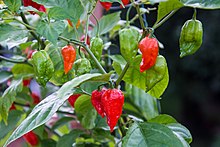| Ghost pepper | |
|---|---|
 Red (ripe) and green ghost pepper fruits | |
| Hybrid parentage | Capsicum chinense × Capsicum frutescens |
| Origin | Northeast India (especially in Assam, Manipur and Nagaland)[1] |
| Heat | |
| Scoville scale | 1,001,304 SHU |
The ghost pepper,[2][3] also known as bhüt jolokia (lit.'Ghost pepper' in Assamese[4]), is an interspecific hybrid chili pepper cultivated in Northeast India.[5][6] It is a hybrid of Capsicum chinense and Capsicum frutescens.[7]
In 2007, Guinness World Records certified that the ghost pepper was the world's hottest chili pepper, 170 times hotter than Tabasco sauce. The ghost chili is rated at more than one million Scoville Heat Units (SHUs) and far surpasses the amount of a cayenne pepper. However, in the race to grow the hottest chili pepper, the ghost chili was superseded by the Trinidad Scorpion Butch T pepper in 2011, the Carolina Reaper in 2013 and Pepper X in 2023.[8]
- ^ It is extensively cultivated in northeastern India, especially in the states of Assam, Nagaland, Manipur. https://www.frontalagritech.com/chillies-peppers-herbs Archived 10 February 2023 at the Wayback Machine
- ^ Gamillo, Elizabeth (3 August 2018). "Ghost peppers are saving U.S. grasslands—by scaring off hungry mice". Science. Archived from the original on 20 March 2022. Retrieved 25 June 2019.
- ^ Deepak, Sharanya (1 January 2019). "The Incredible Story of Bhut Jolokia: From Rural India to Dumb YouTube Stunts". Taste. Retrieved 25 June 2019.
- ^ "Definition of BHUT JOLOKIA". www.merriam-webster.com. Archived from the original on 4 September 2024. Retrieved 26 October 2020.
- ^ Shaline L. Lopez (2007). "NMSU is home to the world's hottest chile pepper". Archived from the original on 19 February 2007. Retrieved 21 February 2007.
- ^ "'Ghost chile' burns away stomach ills - Diet & Nutrition - NBC News". Associated Press. 2007. Archived from the original on 28 February 2013. Retrieved 5 August 2007.
- ^ Paul W. Bosland; Jit B. Baral (2007). "'Bhut Jolokia'—The World's Hottest Known Chile Pepper is a Putative Naturally Occurring Interspecific Hybrid" (PDF). Horticultural Science. 42 (2): 222–4. Archived from the original (PDF) on 23 September 2015. Retrieved 11 July 2014.
- ^ "Hottest Chili". Guinness World Records. Archived from the original on 24 September 2014. Retrieved 11 November 2023.